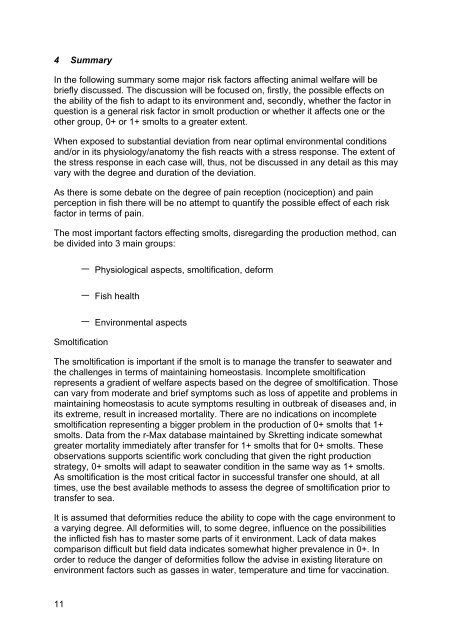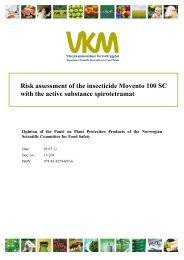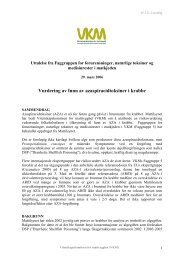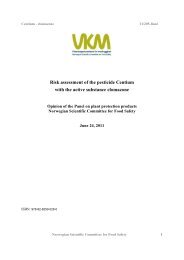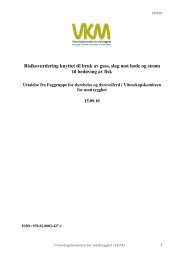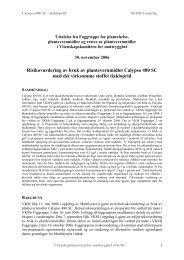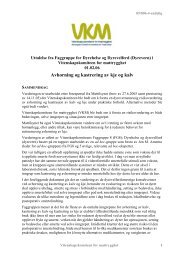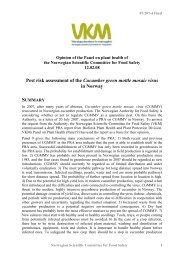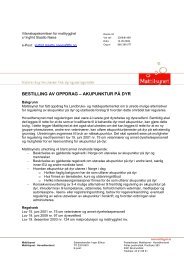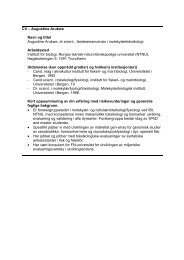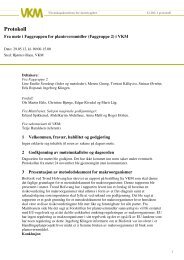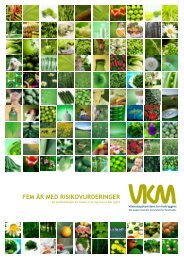Fiskevelferdsmessig vurdering av produksjon av 0-års smolt
Fiskevelferdsmessig vurdering av produksjon av 0-års smolt
Fiskevelferdsmessig vurdering av produksjon av 0-års smolt
Create successful ePaper yourself
Turn your PDF publications into a flip-book with our unique Google optimized e-Paper software.
4 Summary<br />
In the following summary some major risk factors affecting animal welfare will be<br />
briefly discussed. The discussion will be focused on, firstly, the possible effects on<br />
the ability of the fish to adapt to its environment and, secondly, whether the factor in<br />
question is a general risk factor in <strong>smolt</strong> production or whether it affects one or the<br />
other group, 0+ or 1+ <strong>smolt</strong>s to a greater extent.<br />
When exposed to substantial deviation from near optimal environmental conditions<br />
and/or in its physiology/anatomy the fish reacts with a stress response. The extent of<br />
the stress response in each case will, thus, not be discussed in any detail as this may<br />
vary with the degree and duration of the deviation.<br />
As there is some debate on the degree of pain reception (nociception) and pain<br />
perception in fish there will be no attempt to quantify the possible effect of each risk<br />
factor in terms of pain.<br />
The most important factors effecting <strong>smolt</strong>s, disregarding the production method, can<br />
be divided into 3 main groups:<br />
− Physiological aspects, <strong>smolt</strong>ification, deform<br />
− Fish health<br />
− Environmental<br />
aspects<br />
Smoltification<br />
The <strong>smolt</strong>ification is important if the <strong>smolt</strong> is to manage the transfer to seawater and<br />
the challenges in terms of maintaining homeostasis. Incomplete <strong>smolt</strong>ification<br />
represents a gradient of welfare aspects based on the degree of <strong>smolt</strong>ification. Those<br />
can vary from moderate and brief symptoms such as loss of appetite and problems<br />
in<br />
maintaining homeostasis to acute symptoms resulting in outbreak of diseases and, in<br />
its extreme, result in increased mortality. There are no indications on incomplete<br />
<strong>smolt</strong>ification representing a bigger problem in the production of 0+ <strong>smolt</strong>s that 1+<br />
<strong>smolt</strong>s. Data from the r-Max database maintained by Skretting indicate somewhat<br />
greater mortality immediately after transfer for 1+ <strong>smolt</strong>s that for 0+ <strong>smolt</strong>s. These<br />
observations supports scientific work concluding that given the right production<br />
strategy, 0+ <strong>smolt</strong>s will adapt to seawater condition in the same way as 1+ <strong>smolt</strong>s.<br />
As <strong>smolt</strong>ification is the most critical factor in successful transfer one should, at all<br />
times, use the best <strong>av</strong>ailable methods to assess the degree of <strong>smolt</strong>ification prior to<br />
transfer to sea.<br />
It is assumed that deformities reduce the ability to cope with the cage environment to<br />
a varying degree. All deformities will, to some degree, influence on the possibilities<br />
the inflicted fish has to master some parts of it environment. Lack of data makes<br />
comparison difficult but field data indicates somewhat higher prevalence in 0+. In<br />
order to reduce the danger of deformities follow the advise in existing literature on<br />
environment factors such as gasses in water, temperature and time for vaccination.<br />
11


